At the beginning of 2024, the number of electric vehicles in the world grew to reportedly 26-30 million vehicles. This figure depends on whether we count Battery Electric Vehicles (EVs) or also include other plug-in vehicles like Plug-in Hybrid Vehicles (PHEV).
Interestingly, about half of these cars were sold in 2023. Reuters claimed that EV sales in 2023 reached 13.6 million vehicles worldwide.
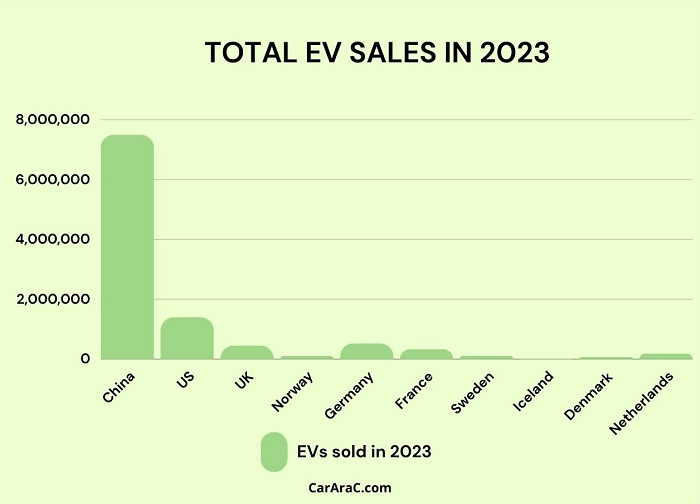
This means the market is on the rise and is just gaining momentum. For example, Statista predicts that by the end of 2025, we'll have about 77 million electric vehicles in the world.
China is claimed by CleanTechnica to be the number one market for EVs with 25% of all new vehicles sold in 2023 being EVs. The market in China is over 30 million vehicles a year.
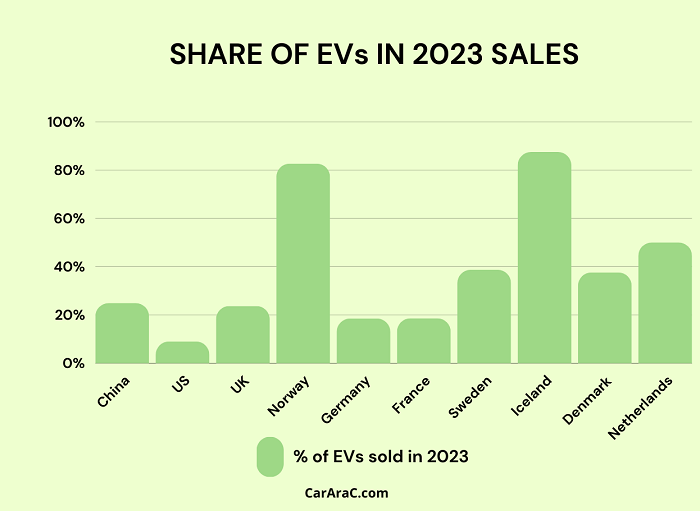
So, what country is now the leader in the number of EVs? How many electric vehicles per 1000 citizens does each country have? And what's the percentage of plug-in vehicles among the entire fleet in each country? Let's investigate!
|
Country |
Light Car Sales 2023 |
EV Sales 2023 |
% of EVs Sold |
|
China |
30,090,000 |
7,500,000 |
24.9% |
|
The US |
15,500,000 |
1,400,000 |
9.0% |
|
The UK |
1,900,000 |
452,000 |
23.7% |
|
Norway |
127,000 |
105,000 |
82.7% |
|
Germany |
2,830,000 |
524,000 |
18.5% |
|
France |
1,770,000 |
329,000 |
18.6% |
|
Sweden |
290,000 |
112,000 |
38.7% |
|
Iceland |
20,000 |
17,500 |
87.5% |
|
Denmark |
173,000 |
65,000 |
37.6% |
|
Netherlands |
370,000 |
185,000 |
50.0% |
As you see, for this investigation, we took 10 countries and will concentrate on them. Larger number of units would take us months to find and investigate the data.
China is home to over 14 Million EVs
For this analysis, we use Wikipedia data for the number of EVs by country. Please note that the data embraces all plug-in vehicles including PHEV.
After quick research, we see that China is the big leader with over 14,100,000 electric vehicles on its roads. About 7.5 million EVs were sold in China in 2023 alone.
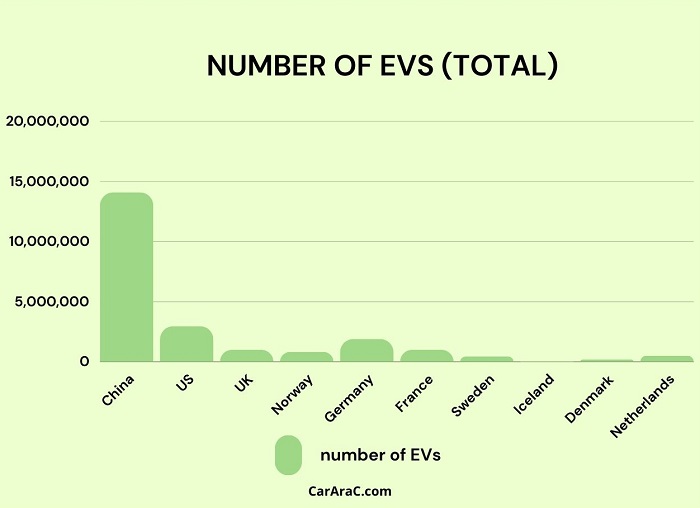
The US comes in second place with just a little under 3,000,000 EVs with just under a half of them being located in California.
Then come some European countries: Germany (1,900,000 EVs), France (1,000,000 EVs), the UK (1,000,000 EVs), Norway (820,000 EVs), etc.
|
Country |
Number of Cars |
Number of EVs |
% of EVs |
|
China |
315,000,000 |
14,100,000 |
4.5% |
|
The US |
305,000,000 |
2,960,000 |
1.0% |
|
The UK |
40,800,000 |
1,000,000 |
2.5% |
|
Norway |
3,400,000 |
820,000 |
24.1% |
|
Germany |
52,300,000 |
1,900,000 |
3.6% |
|
France |
45,300,000 |
1,000,000 |
2.2% |
|
Sweden |
5,640,000 |
440,000 |
7.8% |
|
Iceland |
287,000 |
40,000 |
13.9% |
|
Denmark |
3,150,000 |
200,000 |
6.3% |
|
Netherlands |
10,250,000 |
515,000 |
5.0% |
Although China has 17 times more electric vehicles on its roads than Norway, does it mean we should treat China as the world's leader in electric shift? We don't think so, and we want to research a little deeper.
Norway has 150 EVs per 1000 citizens (17 times more than the US)
For this investigation, we took the Worldometers stats about population by country. Now that we know the number of EVs in a certain country and know the population of that country, let's create a more realistic rating.
We will count the number of electric vehicles per 1000 citizens. And the numbers may be surprising.
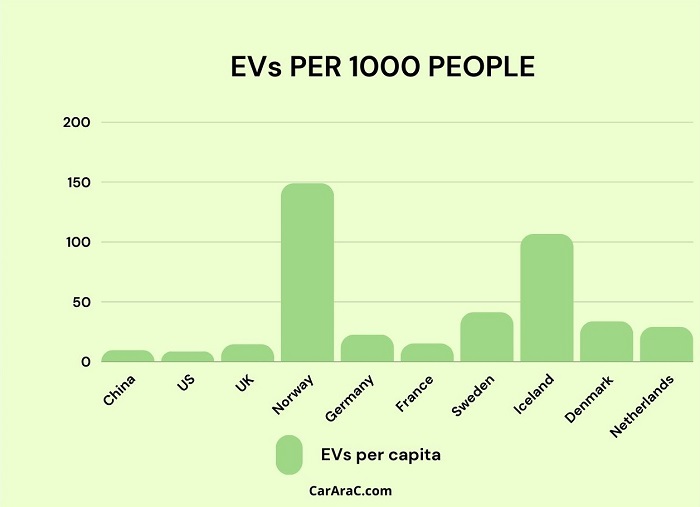
China has 9.9 EVs per 1000 population which is obviously not the greatest result. Then, the US shows 8.7 EVs per 1000 which is even worse than in China (what a shame!)
European markets feel a little better than that. Although they have significantly fewer electric vehicles on their roads than China or the US, the number per 1000 people seems to be much better. For example, in Germany, it's 22.8 EVs per 1000 citizens, and in France - about 15.4 EVs per 1000 citizens. The leaders are Norway (149.1 EVs), Iceland (106.7 EVs), Sweden (41.5 EVs), Denmark (33.9 EVs), and Netherlands (29.3 EVs).
|
Country |
Number of Cars |
Population |
EVs/1000 people |
|
China |
14,100,000 |
1,426,000,000 |
9.9 |
|
The US |
2,960,000 |
340,000,000 |
8.7 |
|
The UK |
1,000,000 |
67,700,000 |
14.8 |
|
Norway |
820,000 |
5,500,000 |
149.1 |
|
Germany |
1,900,000 |
83,300,000 |
22.8 |
|
France |
1,000,000 |
64,800,000 |
15.4 |
|
Sweden |
440,000 |
10,600,000 |
41.5 |
|
Iceland |
40,000 |
375,000 |
106.7 |
|
Denmark |
200,000 |
5,900,000 |
33.9 |
|
Netherlands |
515,000 |
17,600,000 |
29.3 |
Given several renowned statistic magazines claim that EV sales in Norway and Iceland now keep about 80-90% of all light car sales, we should be ready for these figures to change pretty fast.
Only 1.05% of cars on the US roads are EVs
We expected similar results in this part of the research but still decided to count the percentage of EVs in the entire fleet of a certain country.
For quick and proper counting, we took this article on Wikipedia and compared it with the data that we already have (EVs total number). Please look at the table above showing this data.
Here's what we've got:
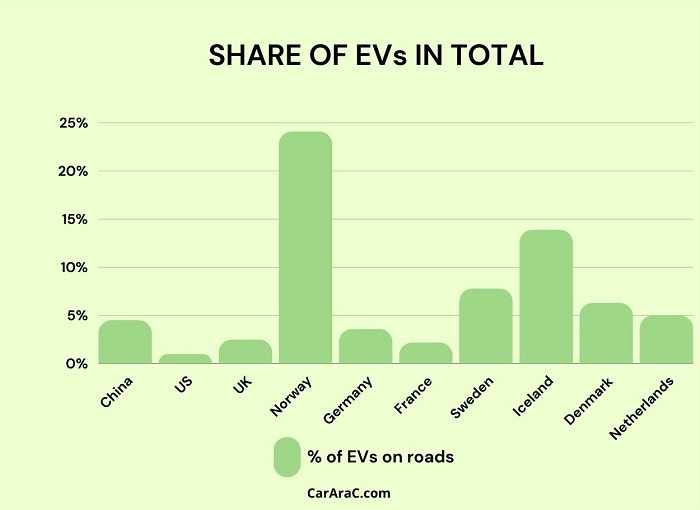
Interestingly, China has only 4.5% EVs among all its vehicles. The US has just slightly fewer cars on its roads than China and the EV fleet accounts for 1.05% of all cars. This is a ridiculously low number!
Again, Norway and Iceland are the obvious leaders accounting for 23.9% and 8.7% respectively.
What conclusions should we make?
Even though China and the US are now at the very center of EV manufacturers' attention, they aren't the actual leaders and pioneers of the EV revolution. Norway is by far the country that has achieved almost a quarter of its fleet being electric.
Also, EV sales show that Norway will continue growing the share of electric vehicles in its fleet faster than other countries with over 90% of all new vehicles sold being plug-in ones with the vast majority of them being EVs, not hybrids.
But the fact is clear: manufacturers don't care about EVs per 1000 citizens or the percentage of the country's fleet being EVs. They care about how many cars they can sell in a certain market. And according to this factor, China and the US are the leading markets.
About the authors
The CarAraC research team is composed of seasoned auto mechanics and automotive industry professionals, including individuals with advanced degrees and certifications in their field. Our team members boast prestigious credentials, reflecting their extensive knowledge and skills. These qualifications include: IMI: Institute of the Motor Industry, ASE-Certified Master Automobile Technicians; Coventry University, Graduate of MA in Automotive Journalism; Politecnico di Torino, Italy, MS Automotive Engineering; Ss. Cyril and Methodius University in Skopje, Mechanical University in Skopje; TOC Automotive College; DHA Suffa University, Department of Mechanical Engineering


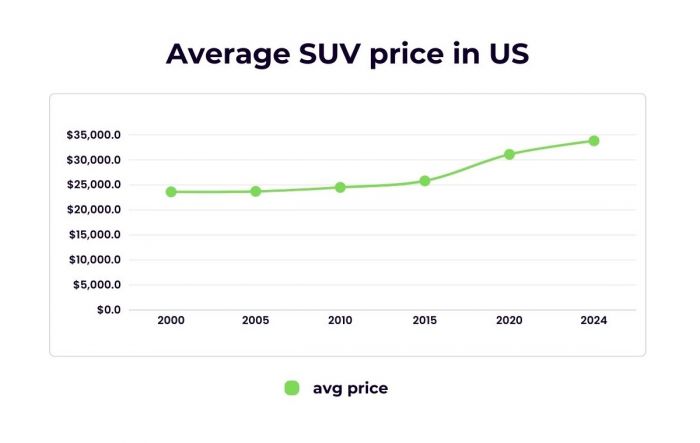



Add comment